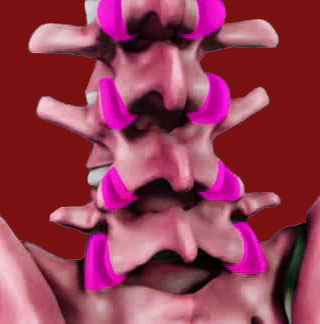
You can utilize our facet joint pain FAQ section to find immediate quality answers to the most frequently asked questions about pain in the spinal facet joints. If you have a facet joint question, then we have your answer right here and now, for free.
This FAQ details questions and answers covering the causes, symptoms and treatments of facet joint pain. Please skip to the appropriate section below to find your question and the reply from our editorial board members. If this facet joint FAQ does not answer your query, feel free to reach out to us directly for assistance.
Facet Joint Pain FAQ About Causes
Q: Why do my facet joints have pain?
A: Facet joints can suffer pain due to the wearing away of the protective parts of the joint, the development of pathological arthritis, injury, as a consequence of some other primary structural spinal modification, like curvature or spondylolisthesis, or due to congenital design flaws. There are many explanations for why facet syndrome might exist, including idiopathic circumstances.
Q: Is facet syndrome the result of a back injury or degeneration?
A: In most cases, facet syndrome is a result of abnormal amounts of degeneration at a particular spinal joint level. In some cases, injury might be a direct cause of facet joint pain or a partial contributor, even years after the trauma occurred.
Q: How do I know if it is my facet joints or some other problem creating my suffering?
A: This is a great question. Facet joint pain is unlike most other forms of back and neck pain in that it produces a very distinct and limited symptomatic profile. An expert in the spine will usually be capable of differentiating facet joint pain from other spinal and nonspinal sources, which is why we highly suggest seeking out a spinal neurologist when evaluating any type of back pain. Read more about all the possible causes of facet joint pain.
Facet Syndrome FAQ About Symptoms
Q: What are the symptoms of facet joint pain?
A: Most patients suffer localized mild to moderate pain in a predictable and static location over the spine upon movement of the affect joint. Facet syndrome symptoms are usually not wide-ranging, severe or involving the muscular tissues of the back or neck.
Q: How do these symptoms differ from other spinal sources of pain?
A: Most forms of back pain can move about, affect large areas of the dorsal anatomy and produce a variety of expressions that facet syndrome is simply incapable of creating. Facet joint syndrome is generally considered a very mild form of back symptomology on the pain scale, compared to most other pathological back pain diagnoses.
Q: Will I become disabled by severe facet joint pain?
A: Disability due to facet joint pain is incredibly unlikely. Some patients suffer acute focal disorders that might greatly diminish their functionality temporarily, but these circumstances virtually always resolve with appropriate treatment.
Facet Joint Pain FAQ About Treatment
Q: What is the best way to treat the spinal facet joints without surgery?
A: Most facet joint symptoms can be managed using conservative and constructive methods of care. It is best to avoid hazardous approaches to treatment, like drugs and injections, whenever possible. Some case profiles will require more extensive or even invasive care in rare circumstances.
Q: Will I require surgery on my spine?
A: It is not likely that you will need facet joint surgery. If you do and the diagnosis is correct, the procedure stands a very good chance of curing the pain.
Q: Should I be considering a non-structural approach like knowledge therapy for my chronic back or neck pain?
A: Yes, of course. Chronic pain and pain that defies treatment are usually indicators of non-structural causation. If you have tried treatments for a diagnosed facet joint condition without success, then implementing knowledge therapy is the next logical step, since the treatment is safe, effective and might provide a complete cure for the pain and other health issues, as well.
Facet Joint Pain > Facet Joint Facts > Facet Joint Pain FAQ





